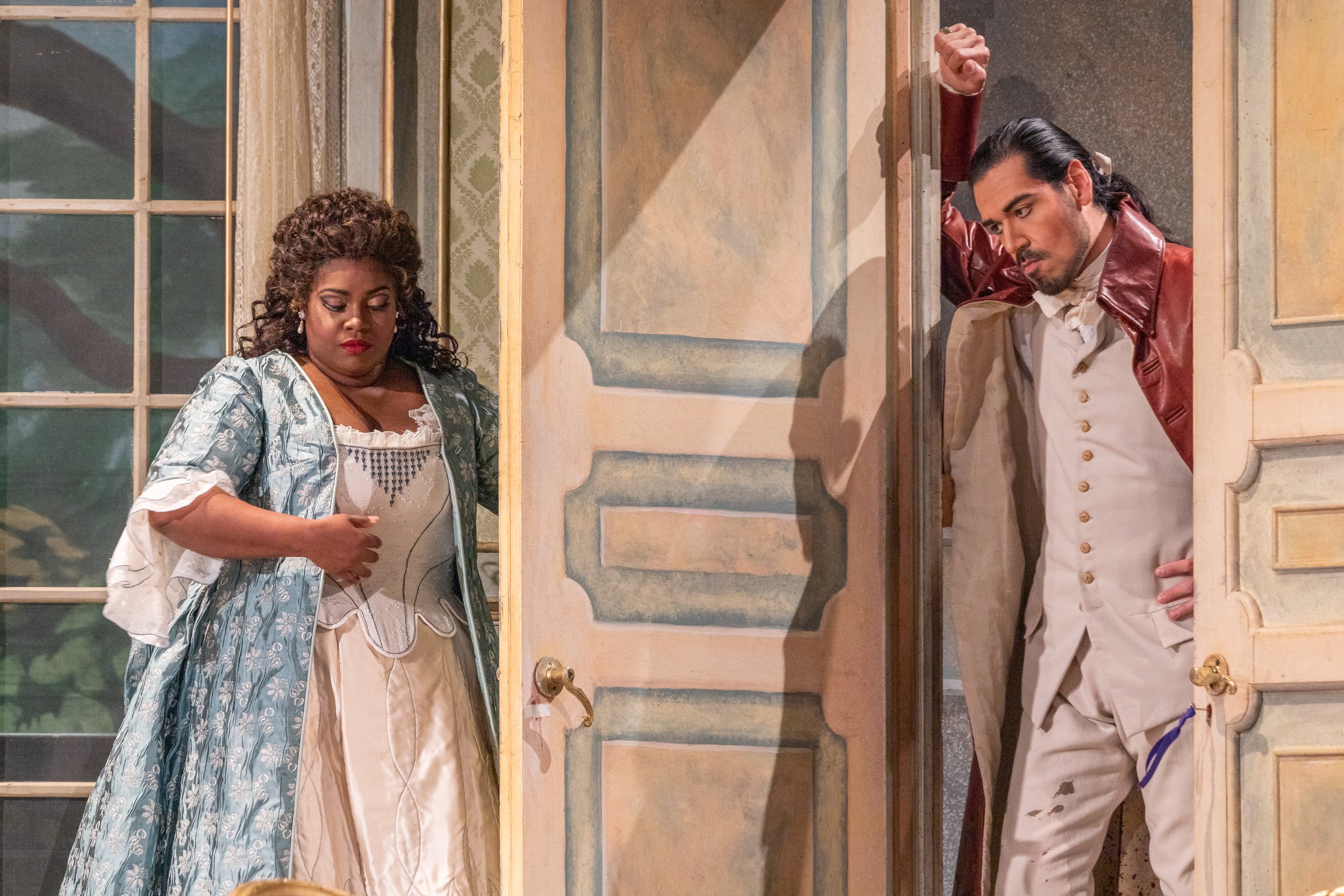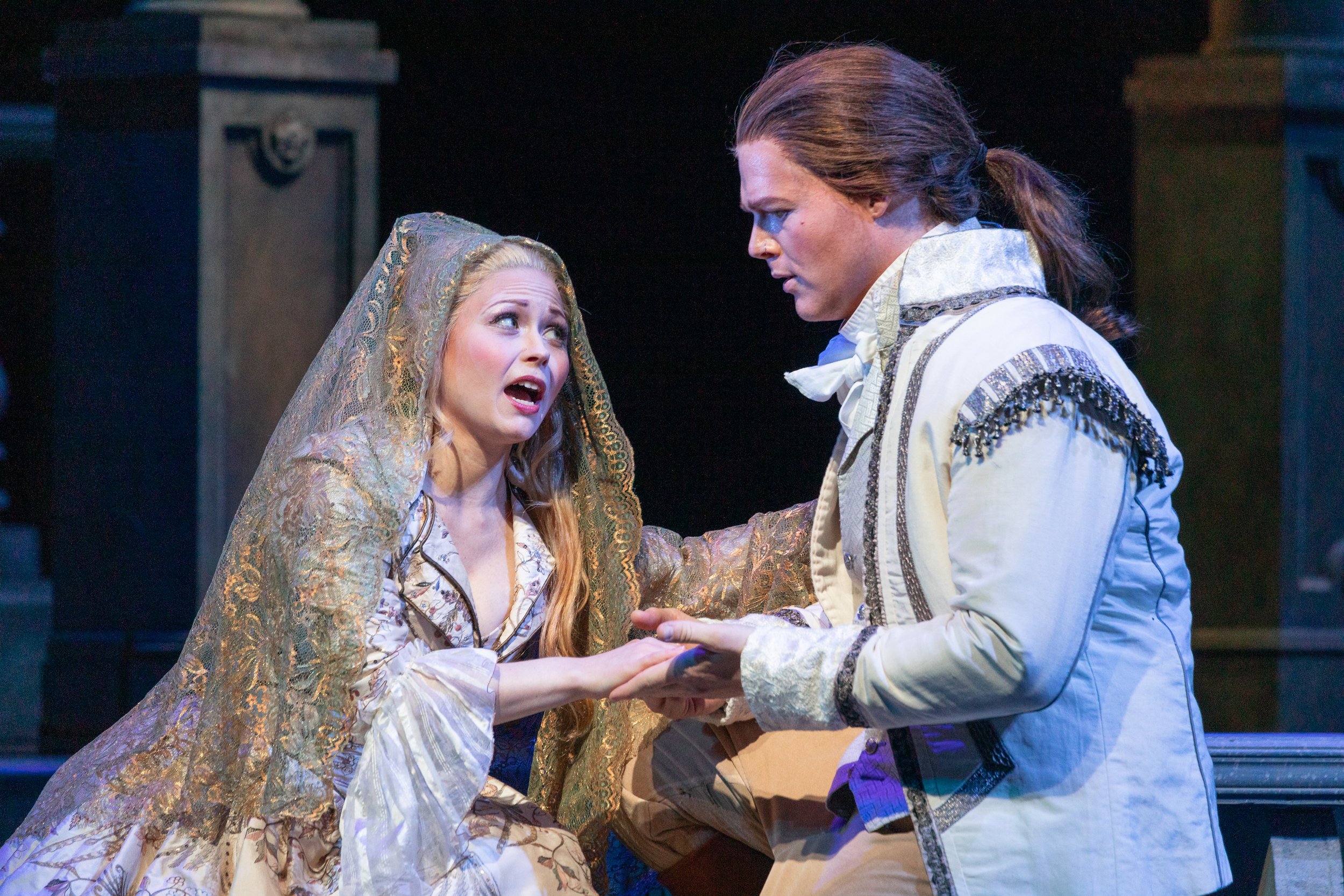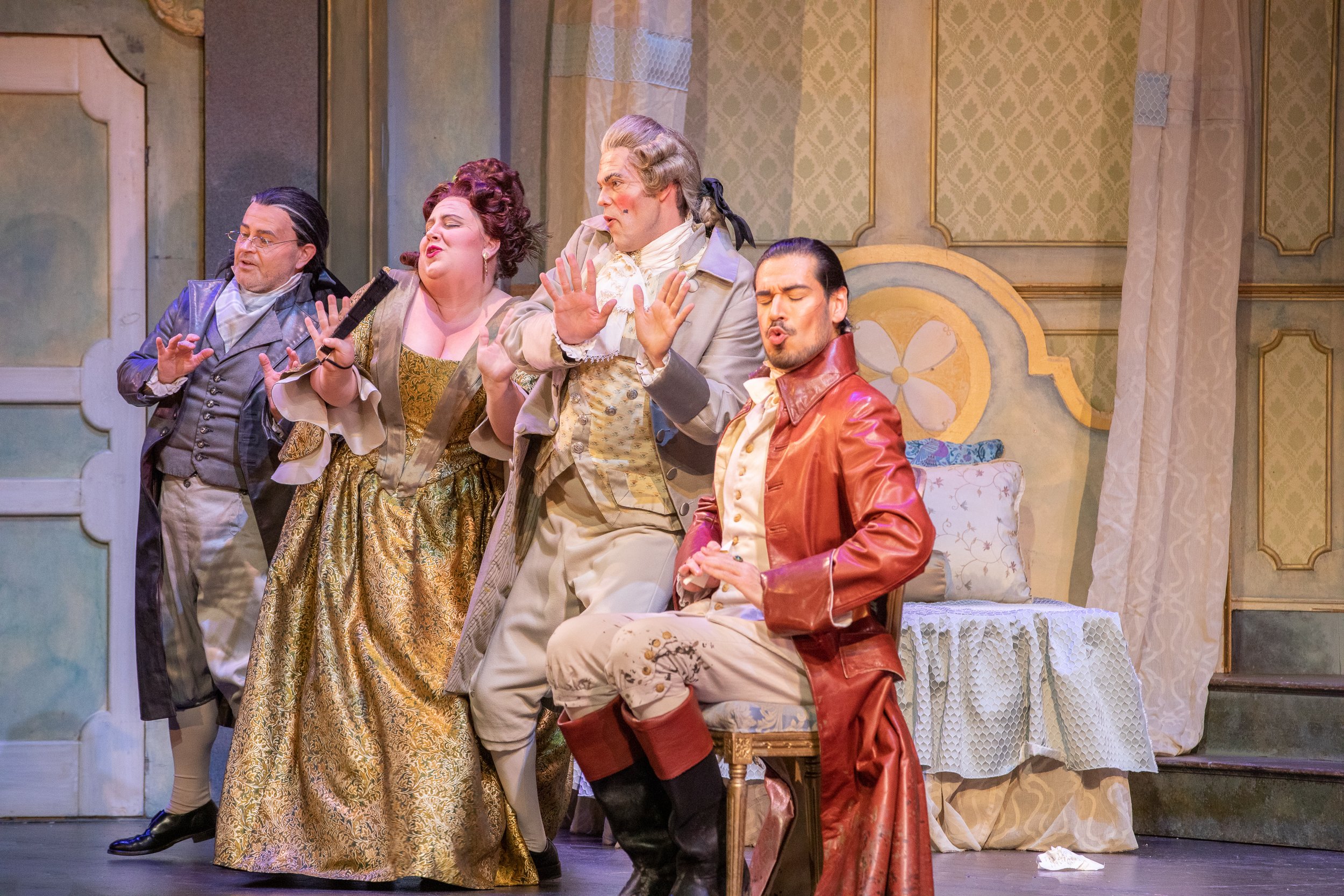VO’s Figaro Saturday night at GMU’s Center for the Arts was a rousing, if uneven production, that judging by comments overheard on exiting, sent everyone home happy. But first:
Thank you, Virginia Opera, for a marvelous season of live performances of great operas produced under the restrictions and the continuing threat of closure caused by the COVID-19 pandemic, including: Wagner’s Das Rheingold in September; Puccini’s La Bohéme: Rodolfo Remembers in November; Heggie’s Three Decembers in February; and Mozart’s The Marriage of Figaro, wrapping up the season this past weekend. Bravi!
Cast of Virginia Opera’s The Marriage of Figaro. Photo by Ben Schill Photography; courtesy of Virginia Opera.
The Marraige of Figaro (Le Nozze di Figaro, 1786) was the first of three operas by the team of composer Wolfgang Amadeus Mozart and librettist Lorenzo Da Ponte that included Don Giovanni followed by Così fan tutte. All three are among the most often performed operas in the repertoire. This team seems an unlikely pairing, the roguish, rookie librettist Da Ponte and the superstar composer Mozart. Da Ponte had written only five librettos before Figaro, two of note, one a success with popular composer Vincente Martin y Soler and one a flop with composer Antonio Salieri, Mozart’s chief rival. Salieri reportedly said that he would rather cut off his fingers than work with Da Ponte again. However, Da Ponte was Austrian Emperor Joseph II’s court poet and a favorite of the emperor. Mozart was no fool and realized the best path to a court sponsored production was to engage Da Ponte, a marriage determined by fate and circumstance, if not made in heaven. Both men were worldly wise.
Symone Harcum as the Countess and Richard Ollarsaba as the Count. Photo by Ben Schill Photography; courtesy of Virginia Opera.
Briefly, in the play, Count Almavira desires to bed Susanna, his wife Rosina’s servant, supposedly justified by droit du seigneur (right of the lord); this is the purported feudal right of a lord to bed a servant girl on her wedding night before her husband can sleep with her, a right the Count himself had just disavowed. Susanna’s betrothed, Figaro, in cahoots with her, the Countess, and a love struck page, Cherubino, lay plans to outwit the Count. Plots and subplots are begun and go astray, and hilarious surprises abound in classical opera buffa style. As was the case for all Mozart/Da Ponte collaborations, there is more afoot than comedy; social change rippling through society at that time is also a subject of the opera. Now, le droit seigneur has a murky history at best from the medieval period and certainly was not found in 18th century Europe. Regardless, it was an excellent plot device for Beaumarchais to make the point quite clearly that nobility had more control over their subjects, even their bodies, than should be granted; this was a controversy roiling aristocracies of the continent at that time. Da Ponte and Mozart bring us to a conclusion that love conquers all and the only path forward is to ask for and give forgiveness and move on. Surely that was the shared belief that allowed them to work together and produce great works. The ending confrontation was set up well by Virginia Opera; when forced to confront his abuse of his wife, the Count asks for forgiveness, and the Countess gives it.
Alisa Jordheim as Susanna and Erik Earl Larson as Figaro. Photo by Ben Schill Photography; courtesy of Virginia Opera.
Mozart suggested to Da Ponte that he write a libretto using Beaumarchais’ play of the same name, the second play in a trilogy about the Count Almavira and Rosina. The first play in the series was The Barber of Seville, later made into the highly successful Rossini opera, and the last play being The Guilty Mother. At the time, The Marriage of Figaro was barred from production in Vienna by the emperor due to incendiary language inspiring subjects to throw off the yoke of the nobility, all this taking place concurrently with the American Revolution, just ten years prior to the French Revolution. The choice of the second play was timely, but Da Ponte had to reduce and modify the spoken play to text that could be sung in an opera that he might be able pass under Joseph II’s radar. Thus, in a scene where Figaro is angry with the Count, the Beaumarchais text reads “Because you are a great lord, you think you are a great genius! You took the trouble to be born, that’s all. You remain nothing but an ordinary man; while I…had to use more science and calculation simply to survive than it has taken to rule Spain for the last hundred years!” See why Emperor Joseph might object to a servant uttering these words? In the opera, Figaro sings, “Well, little count, if you want to dance, I will choose the tune.” The aria makes the point that the servant does not accept the count’s yoke of control, but in a safer manner, especially when flavored by high comedy. Da Ponte and Mozart knew what they were dealing with and how to navigate the terrain, and importantly, they shared a vision that their target was not political upheaval but illuminating the human heart and successfully putting on a good show.
Alisa Jordheim as Susanna, Lauren Cook as Cherubino, and Symone Harcum as the Countess. Photo by Ben Schill Photography; courtesy of Virginia Opera.
Sharing their hearts with ours were twelve named singers, a twelve-member chorus, and two supernumeraries. In a good cast, the standout performances came from bass-baritone Richard Ollarsaba as the Count and soprano Symone Harcum as the Countess. Mr. Ollarsaba, is familiar to area audiences. He was in training with Wolf Trap Opera as a Filene Artist in 2016-2017, and gave a noteworthy performance as Chaplain Raimondo in VO’s 2018 Lucia di Lammermoor. He possesses an appealing voice matched by well-executed vocals and a commanding stage presence; he was an excellent choice for the role of the Count. He is one of a legion of young opera stars in the making whose careers have been greatly impeded by pandemic closures, but keep an eye on him for what appears to be a bright future. The Countess does not appear in the opera until the beginning of Act II. My wife’s first comment to me after the opera was that when soprano Symone Harcum appeared on stage, “She brought life to the party”. Indeed, in many ways the opera itself moved up a notch in Act II. Ms. Harcum’s excellent arias and recitatives easily soared over the orchestra. She had a regal appearance, easily identifiable as the Countess. Her acting as the sad but hopeful wife of a straying husband was touching. Soprano Alisa Jordheim made an appropriately fetching Susanna, though both she and baritone Erik Earl Larson as Figaro seemed a little overwhelmed and possibly out of sync with the orchestra in the early going. Mr. Larson cut a fine figure as Figaro and had a good voice for the role, though his acting might have used more definition. Ms. Jordheim began to really impress with her ensemble singing. Her solo aria “Oh come, don’t delay” teasing her husband in the final act was a highlight of the evening and a fine showcase for her talent.
left to right: Jason Ferrante as Basilio, Whitney Robinson as Marcelina, Erik J. McConnell as Dr. Bartolo, and Richard Ollarsaba as the Count. Photo by Ben Schill Photography; courtesy of Virginia Opera.
In the fifth major role in the opera, mezzo-soprano Lauren Cook displayed dramatic and comedic acting talent as the page Cherubino, a pants role; her vocals at times dropped off and were hidden by the orchestra. Other performers who contributed admirably to the performance were tenor Jason Ferrante in dual roles as the Count’s enabler, Basilio, and notary Don Curzio; baritone-bass Eric J. McConnell as Dr. Bartolo, Figaro’s old nemesis; bass-baritone Chauncey Blade as the drunken gardener Antonio; and the bridesmaids played by sopranos Keely Borland and Tara Hoyle. Sometimes it is the singers in minor roles that catch your eye. Mezzo-soprano Whitney Robinson as Marcellina, the former servant of Dr. Bartolo, was a standout showing a flair for comedy. Soprano Catherine Goode as Barbarino had a voice that brought me to attention and made my ears perk up; her aria in the last act, “I have lost it, poor me”, caused me to hope Virginia Opera will bring her back again in a more prominent role. The Virginia Opera Chorus under the direction of Chorusmaster Brandon Eldredge was a delight. As always, I was so impressed with Mozart’s ability to create ensemble numbers including from two to seven solo singers singing along different lines. VO’s ensemble of singers delivered these in thrilling fashion. It is a shame, I think, that audiences today do not insist on encores of favorite numbers as they did in Mozart’s time. The audiences at the first performances in 1786 insisted on so many encores that Emperor Joseph imposed a rule that encores of ensemble numbers would not be allowed because they caused performances to run too late. I’d be willing to stay.
left photo: Catherine Goode as Barbarina. right photo: Chauncey Blade (center) as the Gardener. Photo by Ben Schill Photography; courtesy of Virginia Opera.
The Richmond Symphony under the direction of Conductor Adam Turner played Mozart’s glorious music beautifully, although the initial response of the woodwinds to the strings beginning the overture seemed a little askew. I thought the volume of the orchestra sounded about right, though at times I had difficulty hearing a few of the singers. Overall, the music was engaging and pleasing throughout the evening. This is definitely an opera where you go home humming the melodies.
Kudos to veteran stage director and choreographer Kyle Lang who directed the production, his fifth directing assignment with Virginia Opera. His gift for comedic embellishments, such as having eavesdropping servants fall through when a door was opened and adding a drunken odor to the gardener, enhanced the performance. His ability to move so many performers around the stage created a natural flow; he even gave us a little ballet in the wedding scene. Having the opening scenes of Act I all take place in Figaro/Susanna’s bedroom seemed a little odd, but it was economical. Director Lang was very good at designing scenes for maximum comic effect where the power advantage was contantly shifting between the characters – where Susanna had the advantage, then Figaro, then the Count, etc. Also, kudos to Set Designer Peter Dean Beck for excellent sets for all the acts and to Costume Designer Paul Brown for great period costumes and to Lighting Designer Driscoll Otto for lighting changes that complemented the action on the stage. This was, overall, an impressive production.
Mozart is the only composer renown for both concert works and operas. It was opera that was his favorite format. Virginia Opera’s performance of The Marriage of Figaro enhanced the impact of Mozart’s music and Da Ponte’s poetry. I very much appreciated the message that Director Lang felt emerges from this opera: “If we genuinely listen to what others need, there is hope for change.”
The Fan Experience: Performances of The Marriage of Figaro occurred on March 25, 26, and 27 in Norfolk, April 1 and 3 in Richmond, and in Fairfax on April 11, 12. The opera was sung in Italian with English supertitles. COVID-19 protocols were in effect for all performances. Joshua Borths, Professor of Music at Capital University, gave the pre-opera talk 45-min prior to performance time. His presentation was a highly informative and entertaining talk that enabled listeners to view the opera with the background that audiences of his day would have had.
Subscriptions are now available for Virginia Opera’s 2022-2023 season at this link. Four operas have been announced and will include the second opera in Wagner’s Ring Cycle, The Valkyrie. This is a follow-up to last year’s The Rhinegold, first in the Cycle, and plans are to present all four. Gilbert and Sullivan’s The Pirates of Penzance, Spears’ Fellow Travelers, and Verdi’s La Traviata finish out the season.







